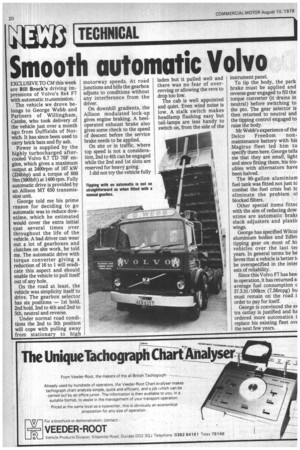Smooth automatic Volvo
Page 22

If you've noticed an error in this article please click here to report it so we can fix it.
EXCLUSIVE TO CM this week are Bill Brock's driving impressions of Volvo's 8x4 F7 with automatic transmission.
The vehicle we drove belongs to George Webb and Partners of Willingham, Cambs, who took delivery of the vehicle just over a month ago from Duffields of Norwich. It has since been used to carry brick bats and fly ash.
Power is supplied by the highly turbocharged aftercooled Volvo 6.7 TD 70F engine, which gives a maximum output at 2400rpm of 167 kW (224bhp) and a torque of 800 Nm (5901bft) at 1400 rpm. Fully automatic drive is provided by an Allison MT 650 transmission unit.
George told me his prime reason for deciding to go automatic was to reduce downtime, which he estimated would cover the extra initial cost several times over throughout the life of the vehicle. A bad driver can wear out a lot of gearboxes and clutches on site work, he told me. The automatic drive with torque converter giving a reduction of 16 to 1 will eradicate this aspect and should enable the vehicle to pull itself out of any hole.
On the road at least, the vehicle was simplicity itself to drive. The gearbox selector has six positions — 1st hold, 2nd hold, 2nd to 4th and 2nd to 5th, neutral and reverse.
Under normal road conditions the 2nd to 5th position will cope with pulling away from stationary to high motorway speeds. At road junctions and hills the gearbox adjusts to conditions without any interference from the driver.
On downhill gradients, the Allison modulated lock-up gives engine braking. A heeloperated exhaust brake also gives some check to the speed of descent before the service brake needs to be applied.
On site or in traffic, where top speed is not a consideration, 2nd to 4th can be engaged while the 2nd and 1st slots are reserved for heavy going.
I did not try the vehicle fully laden but it pulled well and there was no fear of overrevving or allowing the revs to drop too low.
The cab is well appointed and quiet. Even wind noise is low. A stalk switch makes headlamp flashing easy but tail-lamps are less handy to switch on, from the side of the instrument panel.
To tip the body, the park brake must be applied and reverse gear engaged to fill the torque converter (it drains in neutral) before switching to the pto. The gear selector is then returned to neutral and the tipping control engaged to raise the body.
Mr Webb's experience of the Delco Freedom nonmaintenance battery with his Magirus fleet led him to specify them here. George tells me that they are small, light and since fitting them, his troubles with alternators have been halved.
The 90-gallon aluminium fuel tank was fitted not just to combat the fuel crisis but tc eliminate the problem of blocked filters.
Other special items fitte with the aim of reducing dow. ntime are automatic brakE slack adjusters and plasti( wings.
George has specified Wilco) aluminium bodies and Edbr( tipping gear on most of hi: vehicles over the last tel years. In general terms he be lieves that a vehicle is better t( be overspecified in the inter ests of reliability.
Since this Volvo F7 has bee' in operation, it has returned a: average fuel consumption c 37.3.1it/100km (7.56mpg) bu must remain on the road i order to pay for itself.
George is convinced the e). tra outlay is justified and ha ordered more automatics t replace his existing fleet OVE the next few years.




































































































